
Quantum Dots Warm Up LED Lighting
Quantum dots could solve the major problems that are blocking LEDs from broader adoption – but issues related to color, lifetime, cost and mass production must be solved.
Quantum dots and LEDs are from the same family tree, in a sense. They’re both based on semiconductor technology: Quantum dots are nanometer-scale compound semiconductor constructs, and LEDs are semiconductor-based devices. And the former technology could be just the key to help its cousin take command of the lighting and display markets.
Quantum-dot LEDs, or QLEDs, are starting to attract attention because of their possible effects on money, markets and people’s lives. Lighting accounts for about 25 percent of energy consumption worldwide, and a billion people use kerosene lamps, so a better lighting technology could cut energy use and transform the lives of billions, said Tom Morrow, executive vice president for emerging markets for the San Jose, Calif.-based semiconductor trade group SEMI.
For LEDs to achieve this, they must come down significantly in price. Today, LED replacement lighting can cost tens of dollars versus less than a dollar for alternatives. Over the next decade, Morrow is looking for a twentyfold LED cost reduction. With that, SEMI predicts that the LED lighting market will grow to $100 billion annually, exploding from today’s $4 billion.
“The real magic of quantum dots”
But there is more to the issue than mere money. LED bulbs are efficient but have difficulty giving off that warm glow that people prefer; quantum dots could be the best fix for this problem, according to Seth Coe-Sullivan, co-founder and chief technology officer of the startup quantum-dot manufacturing firm QD Vision Inc. of Lexington, Mass.
“The real magic of quantum dots is about color, and that’s color saturation, color tunability and color precision,” he said. “So, for LED lightbulbs and light fixtures, what we’re doing is giving you incandescent color quality.” Technically, this translates to a correlated color temperature of 2700 K and a color rendering index of greater than 90, achieved by sending the light of an LED through a sheet of quantum dots.
QLEDs could be a solution for color and cost, both big challenges. “A good color solution allows the other components in the LED to be less optimized,” SEMI’s Morrow said. This could mean that a less expensive LED or a less costly phosphor could be used.
Some phosphors are made up of rare-earth elements, which can be in short supply and expensive. Also, phosphors tend to emit over a broad spectrum. Thus, many of the photons produced by an LED may be translated by a phosphor into wasted light, which hurts the overall efficiency of the device. Unlike other methods, including the use of a phosphor, quantum dots downshift the color produced by a blue LED efficiently into the green and red. “We’re doing that without wasting photons in other parts of the spectrum, where your eye can’t see them,” Coe-Sullivan said.
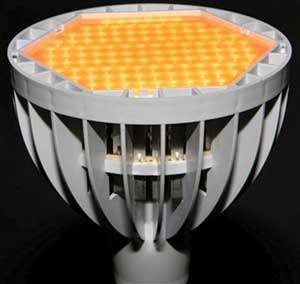
Quantum dots downshift LEDs to produce a soft white light, as in this lightbulb from Nexxus Lighting. Such photoluminescent quantum-dot LEDs are poised for growth in display backlighting and general illumination applications. Courtesy of QD Vision and Nexxus Lighting.
Today’s phosphors are not particularly good at matching the sensitivity of the human eye in the red, said Eric Virey, a senior market and technology analyst for LED devices and materials at technology market analyst firm Yole Développement of Lyons, France. This gives QLEDs an opening because they can improve the color rendering and the efficiency of devices.
This is most important in applications such as LCDs – which can benefit if the backlight emission closely matches color filters – but much less so in general lighting, Virey said. In the former, which includes everything from telephones to televisions, the price differential may be somewhat less of a stumbling block in higher-end displays because they are expected to offer better performance. People generally are willing to pay a premium for better color. Thus, QLEDs may have their greatest initial impact in display backlights.
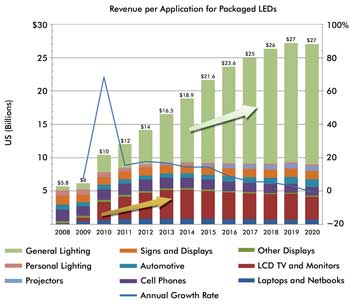
LED revenues by application, in billions of US dollars. The market for LEDs is growing, with backlight applications in TVs and elsewhere driving the industry. In the future, general lighting will dominate, according to Yole Développement, which predicts that the growth seen in 2010 will continue through 2015, thanks to use in light and LCD TV applications. Courtesy of Yole Développement.
Although the overall backlight LED market grew by almost 70 percent in 2010, it will expand only in the low teens this year, Virey said. This is the result of a combination of a slower growth in TV sales and a slower adoption rate of LEDs as a backlight to LCDs. Of the TVs made in 2011 that used a backlight, about four of every 10 used some form of LED.
“There’s still room for LEDs to capture more of the TV market, but we’re getting close to saturation,” Virey said. He noted that, to enter this market in large numbers, QLEDs must help lower overall costs. They face a moving target because phosphors also are coming down in price.
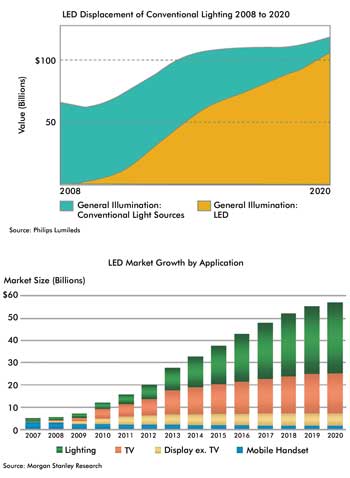
Light is forecast to undergo a transformation as LEDs move into general illumination as replacements for other technologies. Courtesy of SEMI, Philips Lumileds and Morgan Stanley Research.
The use of LEDs in displays is driving investment in the industry and further development of the technology, including QLEDs. The resulting improvements in performance and cost will open up general illumination to the technology, predicts Paul Semenza, senior vice president of analyst services at display market analysis firm DisplaySearch in Santa Clara, Calif.
QLED products on the market
QD Vision is still perfecting its technology, but the company does have some products and prototypes out. For instance, QD Vision and Nexxus Lighting of Charlotte, N.C., announced in 2010 what they called the first commercially available QLED lightbulb with an industry-leading 60-lm/W white-light output.
The product employs photoluminescence. Quantum dots absorb one wavelength of light and emit another, and the emission is determined by the materials and size of the quantum dot. Because the two can be controlled precisely and the emission itself is at most a few tens of nanometers wide, the resulting light can be tuned to achieve the best visual quality and efficiency.
Quantum dots also can generate light via electroluminescence, directly translating electrons into photons. QD Vision demonstrated a 4-in. full-color quantum-dot electroluminescent display last spring.

Electroluminescent quantum-dot LEDs, or QLEDS, are in development. Courtesy of QD Vision.
And last year, the company signed a deal with LG Display of Seoul, South Korea, and chemical company Solvay of Brussels to develop and manufacture an active-matrix display based on the technology. Products from this collaboration remain a work in progress, in part because the lifetime of such devices is, at best, in the 10,000-h range, too low for large displays. There has been progress on that front, however, and devices should appear within three to five years, Coe-Sullivan said.
Other firms also are working on photoluminescent devices. Evident Technologies of Troy, N.Y., is a startup working to commercialize quantum dots, including QLEDs. Earlier this year, it signed an agreement licensing its technology to Samsung Electronics Co. Ltd. of Seoul. The company’s technology also has shown up in consumer products.
A third entry comes courtesy of Nanosys Inc. of Palo Alto, Calif. This startup has agreements with Seoul-based LG Innotek and Samsung Electronics for commercial display applications. Nanosys states that its backlight products can improve LCD color rendering with little change in overall thickness or the manufacturing process. The company reportedly is working on a general illumination product.
Looking down the road, quantum dots likely will start to play a bigger role than as an emission-shifting layer in devices. For example, MIT researchers in Cambridge have examined how quantum dots could be combined with organic semiconductor films to create a version of QLEDs. Somewhat surprisingly, they found that the best results were obtained when the quantum dots were slightly embedded within the organic material, a consequence of the energy-transfer mechanism between the electron transport layers and the photon-emitting quantum dots.
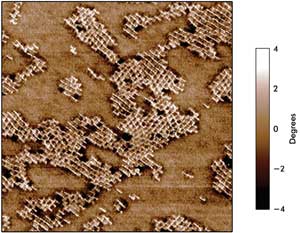
Quantum dots stamped onto a film of NPAPF, an organic semiconductor. The two could form an electroluminescent quantum-dot LED. The 500 x 500-nm image is a phase contrast image from an atomic force microscope. Courtesy of Katherine Aidala, Mount Holyoke College.
Papers on this research appeared in Physics Review B in 2008 by Anikeeva et al, in Nano Letters in 2010 by Panzer et al, and in Physica Status Solidi C in January. Katherine E. Aidala, an assistant professor of physics at Mount Holyoke College in South Hadley, Mass., who was on sabbatical at MIT, was lead author of the latter paper. She said that the relevance of the findings for commercial applications depends upon the materials and the types of processes that are used.
In the April issue of Science, Israeli researchers described a process that produces heavily n- and p-doped quantum dots. Co-author Eran Rabani, a chemical physics professor at Tel Aviv University, said that, in principle, this could be used to enhance QLEDs by allowing quantum dots to incorporate p-n junctions within themselves without significantly affecting their optical properties. However, he added, the concept behind such constructs still must be proved.
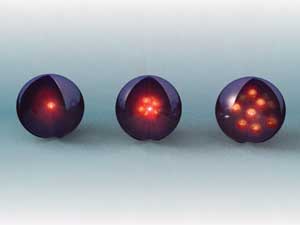
Doped quantum dots, shown in this model progressing from lightly doped on left to heavily doped on right, could enhance the performance of electroluminescent quantum-dot LEDs. Courtesy of Eran Rabani, Tel Aviv University.
These and other electroluminescent quantum-dot devices are years away. In the much shorter term, products will be photoluminescent in nature. There, the challenges of lifetime, temperature stability and large-scale manufacturing either have been solved or are on track to be, industry advocates such as QD Vision’s Coe-Sullivan insist.
Thus, quantum-dot LEDs are no longer a science project.
“Products have already come out and are about to roll out in a very large fashion,” he said. “Quantum dots are a commercial technology.”
/Buyers_Guide/QD_Vision_Inc/c17608